Torfschiffswerft Schlussdorf
The Turf Shipyard (German: Torfschiffswerft) in Schlussdorf, Lower Saxony, Germany, is a former boat builder's yard now used as an open-air museum. The yard, operating from 1850 to 1954, was specialised on barges to transport turf, that is dried peat used as fuel. In 1975 the Heimatverein Schlußdorf[4] (i.e. Schlussdorf Traditions Club) started to rescue the dilapidated shipyard buildings and reopened the site as a museum in 1977. The Turf Shipyard is about 3 kilometres (1.9 mi) north of Worpswede's outskirts.[5]
Torfschiffswerft Schlussdorf | |
 Outdoor area: Boat shelter with ¼-Hunt barge | |
 Location of the museum within Germany | |
| Former name | Grotheersche Torfschiffswerft |
|---|---|
| Established | 13 August 1977 |
| Location | Schlussdorfer Str. 22, D - 27726 Schlussdorf, a locality of Worpswede |
| Coordinates | 53.23560°N 8.97281°E |
| Type | open-air museums, transport museum |
| Key holdings | turf boats, tools and devices for peat cutting, for boat building, for farming and for house-keeping |
| Visitors | 160,000 (1977–2014)[1] |
| Founder | Heimatverein Schlußdorf, then led by Hermann Giere (1920–2016) |
| Director | Siegfried Fest, Horst Flömer and Sonja Melingkat[2] |
| President | Karl-Heinz Melingkat 1993–2014: Dieter Hornig[2] 1975–1993: Hermann Giere[3] |
| Owner | Heimatverein Schlußdorf (i.e. Local Traditions Club) |
| Nearest car park | on the spot |
| Website | www |
The Turf Shipyard is the only of its kind preserved in Northern Germany.[5] As a museum it is undoubtedly in the front row of Worpswede's tourist sights.[2] Among the attractions of the artists' village of Worpswede, the Turf Shipyard museum turned out to be a gem.[1] The visit is especially recommended to people with children, as everything is presented very vividly.[5]
Bogs settled, peat cut and shipped
Following Jürgen Christian Findorff's plans for the inner colonisation[6] in the drained mires of the Teufelsmoor the village of Schlussdorf was founded in 1800 with originally 24 colonist families.[7] Findorff (1720–1792), whom on 20 September 1771 George III of Britain and Hanover had appointed as Mire Commissioner (German: Moorkommissar) for the drainage and colonisation of the Teufelsmoor, included fuel turf sales as the necessary and available financial source for the colonists in their hard initial years.[8]
The colonists sold fuel turf (German: Backtorf) prevailingly in Bremen and cities on the lower Weser,[9] in order to raise money to make a living and build up their farms.[7] By contract with the mire commission each colonist had to commit himself to replace the initial sod roofed A-frame shack by a solid farm building within the span of one year, however, so many failed that the commission already counted the presence of timber as fulfilment of that obligation, and thus some simple mire cottages (German: Moorkate[n]) were still to be found in the 1930s.[10]
As the soil was poor,[11] the farming revenues remained meagre, and their recipients lived in poverty and often suffered from malnutrition and disease such as rickets and tuberculosis.[12] In springtime farmers started to cut peat[13] from a lower peat layer, considered the best for fuel turf.[5] If necessary the farmers compressed the peaty soil before cutting by hours-long barefoot tamping, a procedure called petten in Northern Low Saxon.[14] Then the brick-formed peat pieces were piled up to stacks for drying in the summer sun to become fuel turf,[13] before the deliveries started from autumn till mid-December.[15]
After 1800 turf prices in Bremen soared.[13] In 1830 fuel turf cost Thaler (Thl.) 4 to 8 (about mark [ℳ] 12 to 24) per 1 Hunt, which is 13.567 cubic metres (479.1 cu ft).[16] In his teenage days the Schlussdorf-born Heinrich Schriefer (1847–1912) navigated turf barges to Vegesack and Bremen selling 1 Hunt of fuel turf for Thl. 2⅔ to 3 (about ℳ 16 to 18),[17] as this author of rustic novels described.[18] Between 1866 and 1884 turf prices per Hunt freely delivered rose from ℳ 60 (in 1866 still Thl. 20 circa) to ℳ 72.[19] Selling fuel turf remained a main source of revenues for mire farmers till the begin of the 20th century,[8][13] when modern fertilising sharply increased the harvests.[13] Fuel turf experienced a last boom in demand by the end of the Second World War and in the immediate postwar years.[20] For their own requirements some mire farmers continued heating with fuel turf until the late 1960s.[2]
All the 20 villages newly founded between 1751 and 1808 stretch as linear settlements along a ramrod straight causeway thrown up from material dug out from the drainage ditches running parallelly.[21] The intermediate Royal-Electoral Chamber of Hanover (fiscal authority supervising and controlling the royal-electoral demesnes) and the provincial Bremen-Verden government in Stade paid for their part the main causeways in each village.[21]
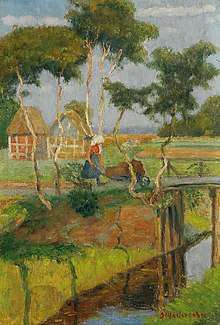
The colonists, again, had to maintain them and to build and to maintain connecting causeways (German: Communicationsdämme, i.e. communication dams) between the villages on their own,[21] as well as all the hydraulic installations (drainage ditches, navigable canals, dikes, weirs, and bridges[15]), to which each colonist had to commit in a contract with the mire commission.[22] All royal-electoral causeways were open to everyone for the public good.[22] Such causeways lacked soil compaction and pavement and were thus impassable for wayns and often even for horses, so inhabitants mostly walked them by foot using – if necessary – wheelbarrows for transport.[21]
In rainy seasons or at seasonal floods the ways turned completely impassable, sometimes for days.[21] In the beginning 30 villages in the Teufelsmoor were only connected by watercourses[23] with 20 villages in the eastern mire part linked through the Wörpe and its tributaries, entering the Wümme.[24] Until the regulation of the river Wörpe in 1860[24] the rather narrower navigable watercourses in its drainage basin only allowed ¼-Hunt barges, thereafter then ½-Hunt barges.[25] Hardly a farmer in the drained mire had a horse,[26] in Schlussdorf e.g. no family had a horse in 1828,[27] they were useless lacking made roads. However, Schlussdorfers had some horned cattle[27] reaching a livestock hardly securing their living only in the second generation.[10] A situation accounted for by the traditional local rhyming saying: Den Eersten sien Dood, den Tweeten sien Nood, den Drütten sien Brood (Northern Low Saxon for: Unto the first his death, unto the second his need, unto the third his bread).
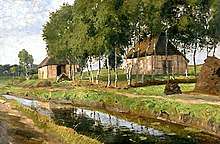
Lacking sufficient travelways the mire colonists also extended drainage ditches to navigability when clearing them, using the dug-out material to raise and repair parallel causeways.[28] Hydraulic engineers and colonists straightened natural rivers and created most of today's watercourses between 1751 and 1799,[15][23] forming a grid expanding to today's length of 222 kilometres (138 mi)[13] to be maintained and financed by the landowners in the drained mire, combined in today's local water board (a public-law corporation), the Gewässer- und Landschaftspflegeverband Teufelsmoor (or GLV Teufelsmoor). Between 1769 and 1790 Findorff directed the construction of the Oste-Hamme Canal,[23] providing for the northerly connection to Bremervörde and Stade.[29] The mire farmers used barges (German: Torfschiff[e]) with no considerable draught capable to cruise the shallow navigable ditches of the Teufelsmoor mire.[30][31]
Once crisscrossed by drainage trenches, hill moors – like the Teufelsmoor – do not well hold water, thus, in order to maintain a navigable water level manually openable sluices (N. Low Saxon: Schütt[en]) were installed every 400 metres (1,300 ft) to 500 metres (1,600 ft) in all the watercourses.[32] In order to pass a Schütt it was to be opened board by board, a time-consuming procedure implying water losses.[33][34] In order to balance these losses streams on the geest had to be tapped, provoking disputes with the inhabitants there.[35]
The Schlussdorf-Winkelmoorer Schiffgraben (Schlussdorf-Winkelmoor shipping ditch) between Schlussdorf and Winkelmoor was laid out on expenses of the Royal-Electoral Chamber in 1810,[36] shortly before the French annexation of the Elbe–Weser triangle.[37] The Schlussdorf-Winkelmoorer Schiffgraben measures 1.542 kilometres (0.958 mi) in length and connects via the river Umbeck to the Hamme.[9] Ten sluices regulated its water level which in 1854 were combined in pairs to form chambers similar to locks able to include up to eight turf barges,[16] obliged to pass in queues to reduce water outflow.[33][34]
_after_M%C3%BCller_and_Witte.jpg)
Since passing sluices is time-consuming, with – in the 1870s – 1,500 turf barges in the Teufelsmoor making up for 9,000 passages per year at, e.g., the Ritterhude Lock,[38] tinkerers plotted a remedy. The canal steward (German: Kanalvogt) Müller from Wörpedorf invented the Klappstau (flap weir)[39] by 1830.[33] It is a leather flap vertically flexible and horizontally enforced by parallel wooden boards applicated on the downstream side and upheld on the upstream side by the headwater and on the downstream side by guiding lateral edges bent upstream.[16] So when a vessel approaches upstream its bow well sticks out above the upper edge of the concavely bent flap weir and by moving on its sloping underside gently presses down the flap, allowing the vessel to skim over it with the swashing downstream torrent.[16] Moving upstream needs more manpower pushing the vessel's bow against the convexly bent flap weir to press it down against the headwater's counterpressure and then steering the barge against the downstream torrent.
Mire Commissioner Claus Witte (1796–1861; 1826–1861 in office) promoted Müller's idea, however, the new practical tool was very expensive, so that it took until 1840 that the first samples got installed in a watercourse at Eickedorf, soon spreading to all navigable watercourses in the Teufelsmoor.[38] In 1856 flap weirs were installed in the Schlussdorf-Winkelmoorer Schiffgraben replacing the previous devices.[36] By straightening the meandering Hamme its course was shortened by half.[40] The southward extension of the old Semkenfahrt by the Semkenfahrtskanal in 1888 and later further on by the Neue Semkenfahrt further shortened the connection between Bremen and the villages north of Worpswede.[41] But navigating on that canals implied dues of three groats for the Semkenfahrt, another three at Höftdeich and six groats at entering Bremen city at the Doventor gate.[42]
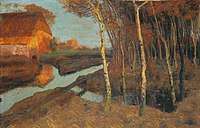
In the Teufelsmoor literally every farming lot is connected to drainage ditches, and the farmers expanded their adjacent ditches to navigable size, or even dug branch ditches to their farmsteads, adding boat sheds where navigability ended.[43] Farmers who could not afford a boat took the services of an Eichenfahrer, a commission shipper from Bremen.[44] Boat sheds mostly disappeared to these days or remain very dilapidated, except of few preserved in museums, such as the Torfschiffswerft in Schlussdorf.[43]
The oldest, and for a long time only made road through the Teufelsmoor, the highway Worpswede-Karlshöfen-Gnarrenburg (today's Lower Saxon L 165), was started in May 1785 by the provincial Bremen-Verden government.[45] Other roads were seasonally so furrowed that pedestrians had to use a side path.[28] Actual paving of causeways only started from 1870 on.[46] Until the end of the First World War causeways had been built to connect all the villages so that many farmers bought for the first time a horse from demobilised army stocks in 1918.[47]
In the 1920s every village paved at least one causeway, usually connecting to the closest paved highway, typically with turf-fired clinker (German: Moorklinker).[46] In the years 1928 and 1929 in Schlussdorf its mayor Diedrich Schnakenberg (1857–1942) propelled paving the first road with clinker, the one to Weyerdeelen-Umbeck, then costing reichsmark (ℛℳ) 210,000, of which the Osterholz district paid one third, while two thirds were personal contributions by the Schlussdorfers.[48] With more and more causeways paved in the Teufelsmoor drainage ditches were put out of navigation.[9] Truck transport replaced canal traffic.[49] In the Great Depression and the early Nazi period more causeways were paved within job creation schemes, with villagers having to feed and lodge the workers in the scheme and provide hand and hitch-up services.[50]
Between 1900 and 1954/1956 the narrow-gauge railway Jan Reiners connected Bremen's Parkbahnhof station with Tarmstedt calling also stations in the Teufelsmoor.[49] Since 1911 the Mire Express railway, since 1978 only operating seasonnally, provides its services.[49]

History of the shipyard
In 1800 Johann 'Jan' Grotheer, then head of one of the 24 original colonist families, took the land lot Schlussdorf #6,[51] readdressed Schlussdorfer Straße 22 in 1978.[52] The Grotheers replaced their initial cottage by a solid farm building by 1820,[53] and in 1850 Jan Grotheer built a boat builder's yard for his son Cord Hinrich Grotheer (1844–1914[1]), at last led by his grandson Hinrich Grotheer (1871–1957).[30] Boat builders established on mire rivers and turf canals, such as in Moorhausen upon Hamme, Mooringen, Trupermoor (there even two), Überhamm and Weyermoor,[54] with Grotheer's in Schlussdorf having then been the best known in all the Teufelsmoor.[1][54]
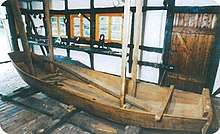
Over three generations the Grotheers launched more than 600 boats within the 104 years of boat building in Schlussdorf.[1][30][54] Without constructional drawings they built their barges, each taking about six weeks of actual boat building.[54] Besides turf barges, mostly for freight (such as fuel turf, or hay to be brought from the remote meadows to the barns at the farmsteads, or construction materials) the Grotheers also built locally typical passenger boats, the so-called Entenjäger (i.e. duck hunter).
Grotheers built their boats from long saisoned 10-metre-long (33 ft) oak wood and supplied them with lugsails of 10 square metres (110 sq ft).[42] The barges from Schlussdorf belong to the class of Halbhuntschiffe with a capacity of c. 6 cubic metres (7.8 cu yd) or 50 standard baskets of turf (½ a Hunt) each.[30] They could not be bigger because the Grotheers launched their turf boats to the Schlussdorf-Winkelmoorer Schiffgraben which – like many of its kind entering the Hamme or the Wümme – does not allow larger barges.[55]
Boatbuilding was poorly paid.[54] In the early 19th century a ½-Hunt barge cost Thl. 80, by its end ℳ 250-300 and ℳ 450 for a full-Hunt barge.[44] In 1934 Heinrich Grabau paid for a ½-Hunt barge ℛℳ 450 to Hinrich Grotheer, with a down payment of ℛℳ 100 for wood.[56] In 1950 a full-Hunt barge cost deutschmark (DM) 1,000.[44]
One 1938-built boat from Schlussdorf is preserved in the Osterholz Traditions Museum in Osterholz-Scharmbeck.[9][52] Another one, built in 1930 in Schlussdorf, was renovated and is now shown in Giehlermoor (a locality of Vollersode).[9] In 1950 the Senate of Bremen ordered the last turf barge[9] in Schlussdorf which Hinrich Grotheer laid down in 1951.[54] The turf barge was completed in 1954[1] and hauled by low-loader to Bremen where it was used as a working boat on the Weser.[48] Decommissioned in 1954 the shipyard went into rack in the following decades,[57] especially after Hinrich Grotheer's death in 1957.[1]

Turf boats
For about 150 years pitch-black turf barges with puce sails were a usual sight in summers and autumns on the watercourses in the Teufelsmoor region.[1] For the shallow mire and drainage watercourses one needs special boats, Torfschiffe.[31] A Torfschiff (literally: turf ship) is a flat-bottomed barge, with similarities to a punt as to construction and propulsion, or a weidling as to material. Torfschiffe can be propelled by poling with quants of 3.6 metres (12 ft) in navigable drainage ditches of 4.5 metres (15 ft) of width or in rivers like Wümme and Lesum,[58] resulting from the former's confluence with the Hamme. However, with wind they can also sail on rivers wide enough. Many watercourses also had lateral towpaths allowing haulage.[2]
The Torfschiff is traditionally constructed from solid wood (oak), seasoned for ten years.[1] The barges, mostly by 10-metre-long (33 ft), were usually built from oaken planks of equal length gained in the geest forests.[30] Shipbuilders originally sawed the floorboards and planks manually from a trunk, later they purchased them sawn from a sawmill and bent them into the required shape.[43] All parts were dowelled with wooden pegs.[54]
Torfschiffe are differentiated by their capacities as Vollhuntschiff (containing up to 1 full Hunt), Halbhuntschiff (up to ½ Hunt) or Viertelhuntschiff (up to ¼ Hunt) with Hunt being a unit of volume for fuel turf (making up 6,480 brick-formed pieces called Soden).[11] The size varieties account for the watercourses' varying widths. Turf barges were delivered fully equipped with sails, mostly from sailmakers in Scharmbeck, with lateral centreboards and quants.[54] When sailing the centreboard serves to stabilise the keelless barge.[2]
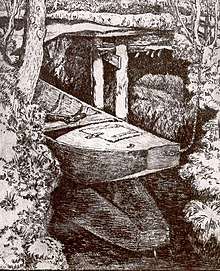
Torfschiffe have no keel, stem, or sternpost. Both the bow and the stern are slightly tapering, with a long shallow underside sloping very gently at the front and the back. The bow usually contained a cabin to rest in.[1] Teufelsmoor farmers delivered fuel turf on barges through drainage ditches, downstream the Weser tributaries.[1] Many ventured on the Weser to supply customers even as far as Brake.[1] A boat tour from Schlussdorf to Bremerhaven could last a week, downstream the Hamme via the Ritterhude Lock, continuing with the confluent Wümme as the Lesum, flowing through Burg upon Lesum down to Vegesack where the Lesum enters the Weser.[2] From the northerly Teufelsmoor it took turf barges two days to get to Vegesack.[2] From there it took them another day to reach Bremen city centre which is located upstream the Weser,[9] whereas Brake or Bremerhaven are downstream.
An alternative route, lasting two days and measuring 28 kilometres (17 mi), would lead after passing Ritterhude into the Wümme and on into the Kleine Wümme in order to reach Bremen's turf harbour (German: Torfhafen) in the northeastern suburb Findorff.[2] There, poor women (the so-called Brockelweiber; i.e. wodge totty), granted besides their day-wage the turf which would drop off, were hired to reload the fuel turf to carts.[58] However, until 1860 this route included two slipways (Low Saxon: Övertog) up and down over dikes, difficult to pass for loaded turf barges,[59] using animal and manpower, one at Dammsiel (Schmidts Övertog in the Lower Blockland), charging 2 groats slip toll,[42] and the other across the Wümme-dike at Kuhsiel in the Upper Blockland.[41] Both slipways were replaced by locks in 1865 (Kuhsiel) and 1896 (Dammsiel).[41]
Museum and Café
In 1975 the members of the Heimatverein Schlußdorf (Schlussdorf Traditions Club) decided to make the rescue of the dilapidated shipyard their collaborative project. Hermann Giere, president of the Heimatverein from 1968 to 1993, then persuaded the Grotheer family[1] to lease the shipyard with its 350 square metres (3,800 sq ft) of land by way of emphyteusis for 99 years to the Heimatverein.[57][60] In 1987 the Heimatverein bought the site from the Grotheer family with financial support by the Worpswede municipality, the Osterholz district and the Landschaftsverband der ehemaligen Herzogtümer Bremen und Verden (association for Stade regional culture, history and economy).[61]
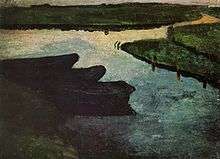
From 1975 to 1977 immediate structural safeguarding measurements rescued the half-timbered shipyard buildings followed by a thorough renovation.[57] The Worpswede municipality and the Osterholz district bestowed one-off grants of DM 15,000 and 25,000 respectively,[57] whereas the club members added own work – 600 hours of handcraftship, 150 hours of transport services, and 1,800 hours of menial work – amounting altogether to an equivalent of DM 60,000.[62]
The museum opened its doors for visitors on 13 August 1977.[63] In the beginning two members of the Grotheer family worked as guides in the boat builder's yard, Beta Grotheer (died in April 1984)[64] and her son Johann Grotheer (died in 1989).[56] Then Jürgen Hägele-Falkenberg became the guide, while Heinz Kommerau offered turf barge tours on the river Hamme.[1] Guided tours are now in the hands of Siegfried Fest, Horst Flömer, and Sonja Melingkat.[2]
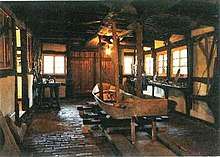
The museum comprises the former shipyard building with 45 square metres (480 sq ft) floor area on the ground level and an exhibition hall of 50 square metres (540 sq ft) in the attic.[62] The builder's yard itself, actually a hall in the ground floor, is just big enough to accommodate a barge ten metres long. Today there is a smaller version, a half-finished passenger boat of the type Entenjäger (duck hunter), on a cradle.[1] Primitive-looking tools for boat building, once used by Cord-Hinrich and Hinrich Grotheer are presented on the hall's walls,[1] such as drills, grindstones and saws of various kinds as well as all sorts of tools for woodworking.[2] They give an idea of the simple means by which these watercraft were built.[5]

In the room next to the hall there are original tools and devices for peat cutting, manual agriculture and clog-making were professionally conservated and are shown as exhibits.[62] Also shown are so-called Brettholschen, mire clogs distributing the weight of the person over a larger area so that the person's foot does not bog down completely.[65] Furthermore, there are a small tin stove on which bargemen on tour warmed up their soup, and a traditional wooden butter churn.[2] Tablets, wall charts, and photos give explanations about draining, cultivating and colonising boglands, an exhibition started in 1981 and renewed and extended ever since.[66] In 1981 the Traditions Club began issuing information brochures on the museum and the subjects it covers, such as colonising boglands, peat-cutting, turf barges etc.[67] Since 1984 the museum also published postcards.[68]
The first heating, an iron stove installed in 1980,[69] was replaced by club members in autumn 1991 by an automated filament heating, subsidised by the Worpswede municipality and Landschaftsverband der ehemaligen Herzogtümer Bremen und Verden.[70] The pit toilet, installed in 1981,[67] is long replaced by up-to-date sanitary fittings.[2] The museum hall was also used for cinema shows. On 5 October 1984 the Bremen State Visual Media Centre (German: Landesbildstelle Bremen) and Helmut Oestmann screened his film 'Bauern im Teufelsmoor' (1931-35; Farmers in the Teufelsmoor) in the museum, also showing Hinrich Grotheer at work building a boat.[71] More films followed.
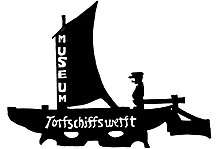
Outdoor area
The museum, surrounded by old oaks which especially in summer invite to linger in the shade, is only a short distance away from the Schlußdorfer Straße.[2] At the end of the driveway, paved with the locally typical peat-fired clinkers and abored with oaks and rhododendrons, a ¼-Hunt barge from 1890 welcomes the visitors in front of the shipyard building.[2] Time seems to have stopped there. The outdoor area is enriched by several additional elements, one of them is a model peat-cutting site.[63] In 1978 Johann Murken designed the museum's logo a metal copy of which was installed as waymarker.[72] The logo shows a turf boat with a bargeman nicknamed by townsfolk as Jan vom Moor (i.e. John from the Mire).[1][44]
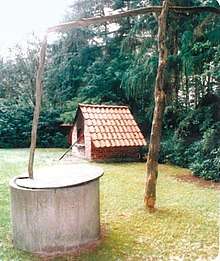
In late summer 1979 the Heimatverein built a carport-like shelter for the 1912-built ¼-Hunt barge[33] which the Wasser- und Bodenverband Teufelsmoor (as the GLV Teufelsmoor was named till 2008) consigned on loan from its collection to the museum.[73] Ernst Soujon thatched the boat shelter in unpaid voluntary work in spring 1991 replacing the previous conventionally modern roof.[74] In 2015 the roof needed a new thatching for approximately € 10,000.[2]
The club members added a draw well in 1980.[1][75] In 1983 club members redesigned the outdoor area also planting rhododendrons which thrive well in the sour soil of the former mire.[76] Master Mason Georg Geffken created in 100 hours of unpaid voluntary work a replica of a traditional brick oven house completed in December 1985,[77] which became centre for a new tradition, the annual Steinofenfest (i.e. stone oven village fête).[2]
_replica.jpg)
In 1988 the Heimatverein bought an additional piece of land from the Grotheers to extend the museum area[78] by a replica of a flap weir (German: Klappstau) built by the club members Waldemar Hartstock and Heinz Kommerau.[33] In 1989 the outdoor area was enhanced by a laden narrow-gauge turf wagon[78] and traditional skeps.[1]
On 22 March 2015 the Heimatverein opened a café in a former flat in the southern wing of the museum's main building.[2] The café's opening hours parallel those of the museum itself. The café seats more than 20 guests inside, and more on the southward terrace, offering hot and cold drinks as well as home-baked cakes.[2] As Karl-Heinz Melingkat, head of the Heimatverein, explained, opening the café follows the request of many visitors for museum tours enhanced by a culinary offer.[2] The café shall further enhance the attractivity of the museum.[2]
One Sunday in July every year club members and other Schlussdorfers celebrate their village fête, the Steinofenfest (i.e. stone oven fête), around and in the museum.[79] In the oven house in the museum's outdoor area villagers bake traditional regional cakes such as Butterkuchen then offered to the guests.[79] Music and dance enhance the fête, ending with a barbeque.[79]
| Year | Vts. | ±% |
|---|---|---|
| 1977–1988 annually | 3,818 | — |
| 1989–1992 annually | 5,050 | +32.3% |
| 1993–2014 annually | 2,276 | −54.9% |
| Numbers are mean sums calculated from attendance sums dividing by the number of years comprised. Source: For 1977–1988 see note[78] For 1989–1992 see footnote[80] For 1993–2014 see footnote[2] | ||
Attendance
The attendance developed encouraging in the first 20 years after opening the museum with more than 4,000 visitors per year, however, by 2015 it had halved. According to another source the number of visitors only slightly declined in the last intervall (4,657 annually).[1] The decline may account for the fact that the museum's exhibition deals with the same subject whereas its counterparts in the heart of Worpswede show altering temporary exhibitions.[2] The small café opened also aims at countering the trend.[2] On Mondays and Tuesdays the museum is closed, however, visits outside the opening times can be agreed beforehand. Entrance fees are moderate.
References
- 10 Jahre Torfschiffswerft (Museum) des Heimatvereins Schlußdorf e.V. Gemeinde Worpswede 1977–1987, Heimatverein Schlußdorf (ed.), Schlussdorf: self-publ., 1988.
- 200 Jahre Schlußdorf 1800–2000: Festschrift zur 200-Jahr-Feier der Ortschaft Schlußdorf, Heimatverein Schlußdorf (ed.), Worpswede: Worpswede municipality, 2000
- Guido Boulboullé and Michael Zeiss, Worpswede: Kulturgeschichte eines Künstlerdorfes, Cologne: DuMont, 1989, ISBN 3-7701-1847-2.
- Die Findorff-Siedlungen im Teufelsmoor bei Worpswede: Ein Heimatbuch, Wolfgang Konukiewitz und Dieter Weiser (eds.), 2nd, revis. ed., Bremen: Edition Temmen, 2013, ISBN 978-3-8378-1003-5.
- Hermann Giere, Torfschiffswerft Schlußdorf (Museum) in der Gemeinde Worpswede, gegr. 1850, restauriert 1977 durch den Heimatverein Schlußdorf e.V., Osterholz-Scharmbeck: Saade, c. 1987.
- Barbara Pannewick, „Worpswede, Heimat der Kunst“, in: Bremen: Entdeckerhandbuch für Stadt und Umland, Sabine Gorsemann (ed.), (=Peter Meyer Reiseführer), Frankfurt upon Main: Peter Meyer, 22005, pp. 171-177.
- Torfschiffswerft Schlußdorf, Heimatverein Schlußdorf (ed.), Worpswede: Atelier Dieter Weiser, [c. 1995].
Notes
- Johann Schriefer, „Torfschiffmuseum ist die Attraktion: In Schlußdorf wurden einst mehr als 600 Kähne gebaut / Werft 1977 restauriert“, in: OHZlive, April 2014, p. 4.
- Michael Schön, „Café im Torfschiffswerft-Museum: Kaffee und Kuchen sollen Besucher locken“, in: Wümme-Zeitung, 11 March 2015, retrieved on 18 November 2019.
- 200 Jahre Schlußdorf 1800–2000: Festschrift zur 200-Jahr-Feier der Ortschaft Schlußdorf, Heimatverein Schlußdorf (ed.), Worpswede: Worpswede municipality, 2000, p. 87. No ISBN.
- In lack of the character ß one can also type two s, thus Schlussdorf instead of Schlußdorf.
- Barbara Pannewick, „Worpswede, Heimat der Kunst“, in: Bremen: Entdeckerhandbuch für Stadt und Umland, Sabine Gorsemann (ed.), (=Peter Meyer Reiseführer), Frankfurt am Main: Peter Meyer, 22005, pp. 171-177, here p. 176. ISBN 3-89859-126-3.
- In 1780 Findorff presented his General Mire Cultivation Plan (German: General-Mohr-Cultur-Plan) according to which the villages Mevenstedt, Tüschendorf (1782 both), Fünfhausen (1783), Winkelmoor (1789), Seehausen (1790), Otterstein (1794), Adolphsdorf and Schlussdorf (1800 both) were created. Cf. Karsten Müller-Scheeßel, „Die Geschichte der Moornutzung und die Entstehung der Findorff-Siedlungen“, in: Die Findorff-Siedlungen im Teufelsmoor bei Worpswede: Ein Heimatbuch, Wolfgang Konukiewitz and Dieter Weiser (eds.), 2nd, revis. ed., Bremen: Edition Temmen, 2013, pp. 41-66, here p. 56. ISBN 978-3-8378-1003-5; also cf. Barbara Pannewick, „Worpswede, Heimat der Kunst“, in: Bremen: Entdeckerhandbuch für Stadt und Umland, Sabine Gorsemann (ed.), (=Peter Meyer Reiseführer), Frankfurt am Main: Peter Meyer, 22005, pp. 171-177, here p. 176. ISBN 3-89859-126-3.
- Hermann Giere, Torfschiffswerft Schlußdorf (Museum) in der Gemeinde Worpswede, gegr. 1850, restauriert 1977 durch den Heimatverein Schlußdorf e.V., Osterholz-Scharmbeck: Saade, c. 1987, p. 3.
- Karsten Müller-Scheeßel, „Die wirtschaftlichen Grundlagen der Findorff-Siedlungen im 18. und 19. Jahrhundert: Landwirtschaft und Torfhandel“, in: Die Findorff-Siedlungen im Teufelsmoor bei Worpswede: Ein Heimatbuch, Wolfgang Konukiewitz und Dieter Weiser (eds.), 2nd, revis. ed., Bremen: Edition Temmen, 2013, pp. 147-169, here p. 164. ISBN 978-3-8378-1003-5.
- Hermann Giere, Torfschiffswerft Schlußdorf (Museum) in der Gemeinde Worpswede, gegr. 1850, restauriert 1977 durch den Heimatverein Schlußdorf e.V., Osterholz-Scharmbeck: Saade, c. 1987, p. 5.
- Johannes Rehder-Plümpe, „Die Gebäude der Findorff-Siedlungen“, in: Die Findorff-Siedlungen im Teufelsmoor bei Worpswede: Ein Heimatbuch, Wolfgang Konukiewitz and Dieter Weiser (eds.), 2nd, revis. ed., Bremen: Edition Temmen, 2013, pp. 125-146, here p. 128. ISBN 978-3-8378-1003-5.
- Guido Boulboullé and Michael Zeiss, Worpswede: Kulturgeschichte eines Künstlerdorfes, Cologne: DuMont, 1989, p. 39. ISBN 3-7701-1847-2.
- Guido Boulboullé and Michael Zeiss, Worpswede: Kulturgeschichte eines Künstlerdorfes, Cologne: DuMont, 1989, pp. 40seq. ISBN 3-7701-1847-2.
- Guido Boulboullé and Michael Zeiss, Worpswede: Kulturgeschichte eines Künstlerdorfes, Cologne: DuMont, 1989, p. 38. ISBN 3-7701-1847-2.
- Guido Boulboullé and Michael Zeiss, Worpswede: Kulturgeschichte eines Künstlerdorfes, Cologne: DuMont, 1989, p. 42. ISBN 3-7701-1847-2.
- Johannes Rehder-Plümpe, „Die Struktur der Findorff-Siedlungen“, in: Die Findorff-Siedlungen im Teufelsmoor bei Worpswede: Ein Heimatbuch, Wolfgang Konukiewitz und Dieter Weiser (eds.), 2nd, revis. ed., Bremen: Edition Temmen, 2013, pp. 93-123, here p. 98. ISBN 978-3-8378-1003-5.
- 200 Jahre Schlußdorf 1800–2000: Festschrift zur 200-Jahr-Feier der Ortschaft Schlußdorf, Heimatverein Schlußdorf (ed.), Worpswede: Worpswede municipality, 2000, p. 30. No ISBN.
- Hermann Giere, 25 Jahre Heimatverein Schlußdorf e.V. 1968–1993, Heimatverein Schlußdorf (ed.), Ritterhude: Diem + Neumann, 1993, p. 48, after Erwin Duwe (erd), „Gedenkstein für Heimatdichter: Vor 139 Jahren wurde Heinrich Schriefer in Schlußdorf geboren“, in: Wümme-Zeitung, 24 January 1986, page unknown.
- Gudrun Scabell, „Der Bauernroman im Teufelsmoor“, in: Die Findorff-Siedlungen im Teufelsmoor bei Worpswede: Ein Heimatbuch, Wolfgang Konukiewitz and Dieter Weiser (eds.), 2nd, revis. ed., Bremen: Edition Temmen, 2013, pp. 249-269, here p. 249. ISBN 978-3-8378-1003-5.
- 200 Jahre Schlußdorf 1800–2000: Festschrift zur 200-Jahr-Feier der Ortschaft Schlußdorf, Heimatverein Schlußdorf (ed.), Worpswede: Worpswede municipality, 2000, p. 32. No ISBN.
- Karsten Müller-Scheeßel, „Die wirtschaftlichen Grundlagen der Findorff-Siedlungen im 18. und 19. Jahrhundert: Landwirtschaft und Torfhandel“, in: Die Findorff-Siedlungen im Teufelsmoor bei Worpswede: Ein Heimatbuch, Wolfgang Konukiewitz und Dieter Weiser (eds.), 2nd, revis. ed., Bremen: Edition Temmen, 2013, pp. 147-169, here p. 169. ISBN 978-3-8378-1003-5.
- Johannes Rehder-Plümpe, „Die Struktur der Findorff-Siedlungen“, in: Die Findorff-Siedlungen im Teufelsmoor bei Worpswede: Ein Heimatbuch, Wolfgang Konukiewitz und Dieter Weiser (eds.), 2nd, revis. ed., Bremen: Edition Temmen, 2013, pp. 93-123, here p. 119. ISBN 978-3-8378-1003-5.
- 200 Jahre Schlußdorf 1800–2000: Festschrift zur 200-Jahr-Feier der Ortschaft Schlußdorf, Heimatverein Schlußdorf (ed.), Worpswede: Worpswede municipality, 2000, pp. 25seq. No ISBN.
- Johannes Rehder-Plümpe, „Die Struktur der Findorff-Siedlungen“, in: Die Findorff-Siedlungen im Teufelsmoor bei Worpswede: Ein Heimatbuch, Wolfgang Konukiewitz and Dieter Weiser (eds.), 2nd, revis. ed., Bremen: Edition Temmen, 2013, pp. 93-123, here p. 99. ISBN 978-3-8378-1003-5.
- Johannes Rehder-Plümpe, „Die Struktur der Findorff-Siedlungen“, in: Die Findorff-Siedlungen im Teufelsmoor bei Worpswede: Ein Heimatbuch, Wolfgang Konukiewitz and Dieter Weiser (eds.), 2nd, revis. ed., Bremen: Edition Temmen, 2013, pp. 93-123, here p. 101. ISBN 978-3-8378-1003-5.
- Johannes Rehder-Plümpe, „Die Struktur der Findorff-Siedlungen“, in: Die Findorff-Siedlungen im Teufelsmoor bei Worpswede: Ein Heimatbuch, Wolfgang Konukiewitz and Dieter Weiser (eds.), 2nd, revis. ed., Bremen: Edition Temmen, 2013, pp. 93-123, here pp. 115seq. ISBN 978-3-8378-1003-5.
- The drained mire with its villages was partioned among four adjacent administrative districts (then in German: Ämter), in 1824 no mire farmer in the Amt Lilienthal owned a horse, in the Amt Osterholz every sixth mire farmer had a horse, while in the Amt Ottersberg every third mire inhabitant kept a horse, whereas in the Amt Bremervörde two thirds of the colonists owned at least one horse. Cf. Johannes Rehder-Plümpe, „Die Gebäude der Findorff-Siedlungen“, in: Die Findorff-Siedlungen im Teufelsmoor bei Worpswede: Ein Heimatbuch, Wolfgang Konukiewitz and Dieter Weiser (eds.), 2nd, revis. ed., Bremen: Edition Temmen, 2013, pp. 125-146, here p. 127. ISBN 978-3-8378-1003-5.
- 200 Jahre Schlußdorf 1800–2000: Festschrift zur 200-Jahr-Feier der Ortschaft Schlußdorf, Heimatverein Schlußdorf (ed.), Worpswede: Worpswede municipality, 2000, p. 28. No ISBN.
- Johannes Rehder-Plümpe, „Die Struktur der Findorff-Siedlungen“, in: Die Findorff-Siedlungen im Teufelsmoor bei Worpswede: Ein Heimatbuch, Wolfgang Konukiewitz und Dieter Weiser (eds.), 2nd, revis. ed., Bremen: Edition Temmen, 2013, pp. 93-123, here p. 120. ISBN 978-3-8378-1003-5.
- Johannes Rehder-Plümpe, „Die Struktur der Findorff-Siedlungen“, in: Die Findorff-Siedlungen im Teufelsmoor bei Worpswede: Ein Heimatbuch, Wolfgang Konukiewitz and Dieter Weiser (eds.), 2nd, revis. ed., Bremen: Edition Temmen, 2013, pp. 93-123, here p. 97. ISBN 978-3-8378-1003-5.
- Hermann Giere, Torfschiffswerft Schlußdorf (Museum) in der Gemeinde Worpswede, gegr. 1850, restauriert 1977 durch den Heimatverein Schlußdorf e.V., Osterholz-Scharmbeck: Saade, c. 1987, p. 4.
- Hermann Giere, 25 Jahre Heimatverein Schlußdorf e.V. 1968–1993, Heimatverein Schlußdorf (ed.), Ritterhude: Diem + Neumann, 1993, p. 27, after NN, „Museumswerft wird eingeweiht: Heimatverein Schlußdorf gibt Gebäude zur Besichtigung frei“, in: Wümme-Zeitung, 16 August 1977, page unknown.
- Johannes Rehder-Plümpe, „Die Struktur der Findorff-Siedlungen“, in: Die Findorff-Siedlungen im Teufelsmoor bei Worpswede: Ein Heimatbuch, Wolfgang Konukiewitz and Dieter Weiser (eds.), 2nd, revis. ed., Bremen: Edition Temmen, 2013, pp. 93-123, here p. 108. ISBN 978-3-8378-1003-5.
- Hermann Giere, 25 Jahre Heimatverein Schlußdorf e.V. 1968–1993, Heimatverein Schlußdorf (ed.), Ritterhude: Diem + Neumann, 1993, p. 51, after Johann Schriefer (jsc), „Heimatverein weihte Klappstau ein: Schlußdorfer Museumsanlage ist um eine Attraktion reicher“, in: Wümme-Zeitung, 4 April 1988, page unknown.
- Johannes Rehder-Plümpe, „Die Struktur der Findorff-Siedlungen“, in: Die Findorff-Siedlungen im Teufelsmoor bei Worpswede: Ein Heimatbuch, Wolfgang Konukiewitz and Dieter Weiser (eds.), 2nd, revis. ed., Bremen: Edition Temmen, 2013, pp. 93-123, here p. 110. ISBN 978-3-8378-1003-5.
- Hans-Gerhard Kulp, „Die Natur des Teufelsmoores“, in: Die Findorff-Siedlungen im Teufelsmoor bei Worpswede: Ein Heimatbuch, Wolfgang Konukiewitz and Dieter Weiser (eds.), 2nd, revis. ed., Bremen: Edition Temmen, 2013, pp. 11-40, here p. 37. ISBN 978-3-8378-1003-5.
- 200 Jahre Schlußdorf 1800–2000: Festschrift zur 200-Jahr-Feier der Ortschaft Schlußdorf, Heimatverein Schlußdorf (ed.), Worpswede: Worpswede municipality, 2000, p. 26. No ISBN.
- The Schiffgraben is today maintained by the GLV Teufelsmoor. Cf. Anlagenverzeichnis GLV Teufelsmoor, Gewässer- und Landschaftspflegeverband Teufelsmoor (ed.), 24 March 2011, p. 13.
- Johannes Rehder-Plümpe, „Die Struktur der Findorff-Siedlungen“, in: Die Findorff-Siedlungen im Teufelsmoor bei Worpswede: Ein Heimatbuch, Wolfgang Konukiewitz and Dieter Weiser (eds.), 2nd, revis. ed., Bremen: Edition Temmen, 2013, pp. 93-123, here p. 112. ISBN 978-3-8378-1003-5.
- Johannes Rehder-Plümpe, „Die Struktur der Findorff-Siedlungen“, in: Die Findorff-Siedlungen im Teufelsmoor bei Worpswede: Ein Heimatbuch, Wolfgang Konukiewitz and Dieter Weiser (eds.), 2nd, revis. ed., Bremen: Edition Temmen, 2013, pp. 93-123, here p. 111. ISBN 978-3-8378-1003-5.
- Johannes Rehder-Plümpe, „Die Struktur der Findorff-Siedlungen“, in: Die Findorff-Siedlungen im Teufelsmoor bei Worpswede: Ein Heimatbuch, Wolfgang Konukiewitz and Dieter Weiser (eds.), 2nd, revis. ed., Bremen: Edition Temmen, 2013, pp. 93-123, here p. 100. ISBN 978-3-8378-1003-5.
- Johannes Rehder-Plümpe, „Die Struktur der Findorff-Siedlungen“, in: Die Findorff-Siedlungen im Teufelsmoor bei Worpswede: Ein Heimatbuch, Wolfgang Konukiewitz and Dieter Weiser (eds.), 2nd, revis. ed., Bremen: Edition Temmen, 2013, pp. 93-123, here p. 105. ISBN 978-3-8378-1003-5.
- 200 Jahre Schlußdorf 1800–2000: Festschrift zur 200-Jahr-Feier der Ortschaft Schlußdorf, Heimatverein Schlußdorf (ed.), Worpswede: Worpswede municipality, 2000, p. 42. No ISBN.
- Johannes Rehder-Plümpe, „Die Struktur der Findorff-Siedlungen“, in: Die Findorff-Siedlungen im Teufelsmoor bei Worpswede: Ein Heimatbuch, Wolfgang Konukiewitz and Dieter Weiser (eds.), 2nd, revis. ed., Bremen: Edition Temmen, 2013, pp. 93-123, here p. 117. ISBN 978-3-8378-1003-5.
- Johannes Rehder-Plümpe, „Die Struktur der Findorff-Siedlungen“, in: Die Findorff-Siedlungen im Teufelsmoor bei Worpswede: Ein Heimatbuch, Wolfgang Konukiewitz and Dieter Weiser (eds.), 2nd, revis. ed., Bremen: Edition Temmen, 2013, pp. 93-123, here p. 116. ISBN 978-3-8378-1003-5.
- Johannes Rehder-Plümpe, „Die Struktur der Findorff-Siedlungen“, in: Die Findorff-Siedlungen im Teufelsmoor bei Worpswede: Ein Heimatbuch, Wolfgang Konukiewitz and Dieter Weiser (eds.), 2nd, revis. ed., Bremen: Edition Temmen, 2013, pp. 93-123, here pp. 119seq. ISBN 978-3-8378-1003-5.
- Johannes Rehder-Plümpe, „Die Struktur der Findorff-Siedlungen“, in: Die Findorff-Siedlungen im Teufelsmoor bei Worpswede: Ein Heimatbuch, Wolfgang Konukiewitz and Dieter Weiser (eds.), 2nd, revis. ed., Bremen: Edition Temmen, 2013, pp. 93-123, here p. 121. ISBN 978-3-8378-1003-5.
- Johannes Rehder-Plümpe, „Die Gebäude der Findorff-Siedlungen“, in: Die Findorff-Siedlungen im Teufelsmoor bei Worpswede: Ein Heimatbuch, Wolfgang Konukiewitz and Dieter Weiser (eds.), 2nd, revis. ed., Bremen: Edition Temmen, 2013, pp. 125-146, here p. 137. ISBN 978-3-8378-1003-5.
- 200 Jahre Schlußdorf 1800–2000: Festschrift zur 200-Jahr-Feier der Ortschaft Schlußdorf, Heimatverein Schlußdorf (ed.), Worpswede: Worpswede municipality, 2000, p. 47. No ISBN.
- Johannes Rehder-Plümpe, „Die Struktur der Findorff-Siedlungen“, in: Die Findorff-Siedlungen im Teufelsmoor bei Worpswede: Ein Heimatbuch, Wolfgang Konukiewitz and Dieter Weiser (eds.), 2nd, revis. ed., Bremen: Edition Temmen, 2013, pp. 93-123, here p. 123. ISBN 978-3-8378-1003-5.
- Johannes Rehder-Plümpe, „Die Struktur der Findorff-Siedlungen“, in: Die Findorff-Siedlungen im Teufelsmoor bei Worpswede: Ein Heimatbuch, Wolfgang Konukiewitz and Dieter Weiser (eds.), 2nd, revis. ed., Bremen: Edition Temmen, 2013, pp. 93-123, here p. 122. ISBN 978-3-8378-1003-5.
- 200 Jahre Schlußdorf 1800–2000: Festschrift zur 200-Jahr-Feier der Ortschaft Schlußdorf, Heimatverein Schlußdorf (ed.), Worpswede: Worpswede municipality, 2000, p. 22. No ISBN.
- 200 Jahre Schlußdorf 1800–2000: Festschrift zur 200-Jahr-Feier der Ortschaft Schlußdorf, Heimatverein Schlußdorf (ed.), Worpswede: Worpswede municipality, 2000, p. 43. No ISBN.
- Gem., „Butterkuchen lockte viele Gäste: Der Heimatverein Schlußdorf feiert sein traditionelles Backofenfest“, in: Wümme-Zeitung, 30 July 1992, p. IV.
- Johannes Rehder-Plümpe, „Die Struktur der Findorff-Siedlungen“, in: Die Findorff-Siedlungen im Teufelsmoor bei Worpswede: Ein Heimatbuch, Wolfgang Konukiewitz and Dieter Weiser (eds.), 2nd, revis. ed., Bremen: Edition Temmen, 2013, pp. 93-123, here p. 118. ISBN 978-3-8378-1003-5.
- Johannes Rehder-Plümpe, „Die Struktur der Findorff-Siedlungen“, in: Die Findorff-Siedlungen im Teufelsmoor bei Worpswede: Ein Heimatbuch, Wolfgang Konukiewitz and Dieter Weiser (eds.), 2nd, revis. ed., Bremen: Edition Temmen, 2013, pp. 93-123, here pp. 116seq. ISBN 978-3-8378-1003-5.
- Hermann Giere, 25 Jahre Heimatverein Schlußdorf e.V. 1968–1993, Heimatverein Schlußdorf (ed.), Ritterhude: Diem + Neumann, 1993, p. 57, after RB., „Torfschiffswerft fand bundesweit Interesse: Heimatverein Schlußdorf zog Bilanz“, in: Osterholzer Anzeiger, 31 January 1990, page unknown.
- Hermann Giere, Torfschiffswerft Schlußdorf (Museum) in der Gemeinde Worpswede, gegr. 1850, restauriert 1977 durch den Heimatverein Schlußdorf e.V., Osterholz-Scharmbeck: Saade, c. 1987, p. 6.
- 200 Jahre Schlußdorf 1800–2000: Festschrift zur 200-Jahr-Feier der Ortschaft Schlußdorf, Heimatverein Schlußdorf (ed.), Worpswede: Worpswede municipality, 2000, p. 45. No ISBN.
- Johannes Rehder-Plümpe, „Die Struktur der Findorff-Siedlungen“, in: Die Findorff-Siedlungen im Teufelsmoor bei Worpswede: Ein Heimatbuch, Wolfgang Konukiewitz and Dieter Weiser (eds.), 2nd, revis. ed., Bremen: Edition Temmen, 2013, pp. 93-123, here p. 94. ISBN 978-3-8378-1003-5.
- Hermann Giere, 25 Jahre Heimatverein Schlußdorf e.V. 1968–1993, Heimatverein Schlußdorf (ed.), Ritterhude: Diem + Neumann, 1993, p. 51, after Johann Schriefer (jsc), „Viele Gäste kamen zum Museums-Jubiläum: Torfschiffswerft Schlußdorf besteht 10 Jahre“, in: Wümme-Zeitung, 2 August 1988, page unknown.
- Hermann Giere, Torfschiffswerft Schlußdorf (Museum) in der Gemeinde Worpswede, gegr. 1850, restauriert 1977 durch den Heimatverein Schlußdorf e.V., Osterholz-Scharmbeck: Saade, c. 1987, p. 8.
- Hermann Giere, Torfschiffswerft Schlußdorf (Museum) in der Gemeinde Worpswede, gegr. 1850, restauriert 1977 durch den Heimatverein Schlußdorf e.V., Osterholz-Scharmbeck: Saade, c. 1987, p. 7.
- Hermann Giere, 25 Jahre Heimatverein Schlußdorf e.V. 1968–1993, Heimatverein Schlußdorf (ed.), Ritterhude: Diem + Neumann, 1993, p. 29, after „Zehn Jahre Heimatverein Schlußdorf: Schon über 2600 Besucher im Torfschiffahrtsmuseum“, in: Osterholzer Anzeiger, 1978, page unknown.
- Johann Schriefer (jsc), „Heimatverein besteht 15 Jahre: Schlußdorfer feierten Geburtstag / Ehrengäste würdigten Aktivitäten“, in: Wümme-Zeitung, 10 April 1984, p. II.
- Wolfgang Konukiewitz, „Torfstechen“, in: Die Findorff-Siedlungen im Teufelsmoor bei Worpswede: Ein Heimatbuch, Wolfgang Konukiewitz and Dieter Weiser (eds.), 2nd, revis. ed., Bremen: Edition Temmen, 2013, pp. 171-189, here p. 182. ISBN 978-3-8378-1003-5.
- Hermann Giere, 25 Jahre Heimatverein Schlußdorf e.V. 1968–1993, Heimatverein Schlußdorf (ed.), Ritterhude: Diem + Neumann, 1993, p. 37, after Johann Schriefer (jsc), „Bilddokumentation im Torfschiffmuseum“, in: Wümme-Zeitung, 1982, page unknown.
- Hermann Giere, 25 Jahre Heimatverein Schlußdorf e.V. 1968–1993, Heimatverein Schlußdorf (ed.), Ritterhude: Diem + Neumann, 1993, p. 35, after Johann Schriefer (jsc), „Museumsbesuch sogar aus Belgien: Heimatverein Schlußdorf mit Jahresverlauf 1981 zufrieden“, in: Wümme-Zeitung, 1982, page unknown.
- Hermann Giere, 25 Jahre Heimatverein Schlußdorf e.V. 1968–1993, Heimatverein Schlußdorf (ed.), Ritterhude: Diem + Neumann, 1993, p. 42, after Johann Schriefer (jsc), „Männer der ersten Stunden geehrt: Heimatverein Schlußdorf besucht den Prickingshof", in: Wümme-Zeitung, 5 May 1984, page unknown.
- Hermann Giere, 25 Jahre Heimatverein Schlußdorf e.V. 1968–1993, Heimatverein Schlußdorf (ed.), Ritterhude: Diem + Neumann, 1993, p. 33, after Johann Schriefer (jsc), „Jetzt erst so richtig gemütlich: Im Torfschiffmuseum wurde eiserner Kaminofen aufgestellt“, in: Wümme-Zeitung, 1980, page unknown.
- Hermann Giere, 25 Jahre Heimatverein Schlußdorf e.V. 1968–1993, Heimatverein Schlußdorf (ed.), Ritterhude: Diem + Neumann, 1993, p. 63, after Johann Schriefer (jsc), „Torfschiffmuseum erhielt Heizung: Gemeinde und Landschaftsverband gewährten Zuschüsse“, in: Wümme-Zeitung, 30 January 1992, page unknown.
- Hermann Giere, 25 Jahre Heimatverein Schlußdorf e.V. 1968–1993, Heimatverein Schlußdorf (ed.), Ritterhude: Diem + Neumann, 1993, p. 43, after Johann Schriefer (jsc), „Torfschiffahrt wurde lebendig: Film 'Bauern im Teufelsmoor' zeigte die harte Wirklichkeit“, in: Wümme-Zeitung, 8 October 1984, page unknown.
- Hermann Giere, 25 Jahre Heimatverein Schlußdorf e.V. 1968–1993, Heimatverein Schlußdorf (ed.), Ritterhude: Diem + Neumann, 1993, p. 28, after Johann Schriefer (jsc), „Originelles Hinweisschild“, in: Wümme-Zeitung, 1978, page unknown.
- Hermann Giere, 25 Jahre Heimatverein Schlußdorf e.V. 1968–1993, Heimatverein Schlußdorf (ed.), Ritterhude: Diem + Neumann, 1993, p. 31, after Wp., „Vor dem Werftmuseum steht ein Viertelhunt: Heimatverein Schlußdorf polierte Torfkahn auf“, in: Osterholzer Anzeiger, 18 October 1979, page unknown.
- Hermann Giere, 25 Jahre Heimatverein Schlußdorf e.V. 1968–1993, Heimatverein Schlußdorf (ed.), Ritterhude: Diem + Neumann, 1993, p. 62, after Maw., „Torfkahnschuppen erhielt ein neues Reetdach“, in: Osterholzer Anzeiger, 26 June 1991, page unknown.
- Hermann Giere, 25 Jahre Heimatverein Schlußdorf e.V. 1968–1993, Heimatverein Schlußdorf (ed.), Ritterhude: Diem + Neumann, 1993, p. 29, after Wp., „Im Ziehbrunnen steht Wasser: Heimatverein Schlußdorf zog erfolgreiche Bilanz“, in: Wümme-Zeitung, 1980, page unknown.
- Hermann Giere, 25 Jahre Heimatverein Schlußdorf e.V. 1968–1993, Heimatverein Schlußdorf (ed.), Ritterhude: Diem + Neumann, 1993, p. 40, after Johann Schriefer (jsc), „Torfschiffmuseum war gut besucht: Der Heimatverein Schlußdorf besteht jetzt 15 Jahre“, in: Wümme-Zeitung, 1984, page unknown.
- Hermann Giere, 25 Jahre Heimatverein Schlußdorf e.V. 1968–1993, Heimatverein Schlußdorf (ed.), Ritterhude: Diem + Neumann, 1993, p. 47, after Her., „Backofenabnahme in Schlußdorf: Das Anbacken muß noch warten“, in: Neue Anzeigen-Zeitung, 4 December 1985, page unknown.
- Hermann Giere, 25 Jahre Heimatverein Schlußdorf e.V. 1968–1993, Heimatverein Schlußdorf (ed.), Ritterhude: Diem + Neumann, 1993, p. 55, after Johann Schriefer (jsc), „Heimatverein Schlußdorf war recht faktiv: Hermann Giere wurde erneut als Vorsitzender bestätigt / Jubiläumsfeier am 11. Juni“, in: Wümme-Zeitung, 2 February 1989, page unknown.
- Michael Wilke (wim), „Backofenfest des Heimatvereins“, in: Weser-Kurier, 10 July 2012, retrieved on 15 November 2019.
- Hermann Giere, 25 Jahre Heimatverein Schlußdorf e.V. 1968–1993, Heimatverein Schlußdorf (ed.), Ritterhude: Diem + Neumann, 1993, p. 67, after Bb., „Schon 62 159 Besucher im Torfschiffmuseum: Mitglieder des Heimatvereins Schlußdorf zogen eine positive Bilanz“, in: Wümme-Zeitung, 26 January 1993, page unknown.
External links

- „Torfschiffswerft-Museum Schlussdorf“, on: Osterholz District Navigator, retrieved on 14 March 2015. (in German)
- „Heimatverein Schlußdorf“, on: Landschaftsverband der ehemaligen Herzogtümer Bremen und Verden, Stade (association for Stade regional culture, history and economy), retrieved on 14 March 2015. (in German)
- „Torfschiffswerft-Museum“, on: Worpswede (municipal website), retrieved on 14 March 2015. (in German)
- Video by the Weser-Kurier, 9 May 2011 (in German)
- Bauern im Teufelsmoor, 1931 by Helmut Oestmann, filmography, preserved in the Bremen State Film Archive.